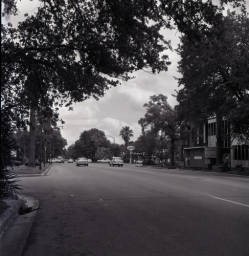Montrose Boulevard: A Tale of Contrasts

Stretching from the iconic Mecom Fountain at the edge of Hermann Park through the Museum District, Montrose Boulevard has witnessed the evolution of Houston's landscape, from the opulent mansions of oil tycoons to a hub of counterculture and artistic expression. But how did it become the eclectic mix of the city's finest and most colorful elements?
In the early 20th century, Houston experienced rapid growth fueled by the burgeoning oil industry. Streetcar suburbs emerged on the western edge of the city, with neighborhoods like Courtlandt Place, Westmoreland, and Avondale offering homes for middle-income and affluent residents seeking to escape downtown. Montrose Boulevard, developed by the Houston Land Corporation, boasted grand mansions, palm-lined esplanades, and an air of sophistication reminiscent of upscale Southern neighborhoods.
Prominent figures such as Howard Hughes, Jr. and Joseph Cullinan left their mark on Montrose, with Hughes growing up nearby and Cullinan establishing exclusive enclaves like Shadyside. However, the absence of formal zoning regulations allowed for the gradual transition of Montrose from a residential haven to a diverse landscape of nonresidential and unrestricted buildings.
The expiration of deed restrictions in 1936 marked a turning point for Montrose Boulevard, paving the way for a wave of new developments ranging from hotels and churches to strip malls and gas stations. The addition of a road connecting Montrose to the Heights altered the street's character further, reflecting the city's decentralization and the shift towards automobile-centric lifestyles.
As Houstonians migrated outward, Montrose experienced a slow decline, exacerbated by the departure of residents and the relaxation of deed restrictions. Yet, amidst this transformation, Montrose emerged as a vibrant community, attracting artists, musicians, and free spirits who found solace in its bohemian atmosphere. Landmark venues like Anderson Fair became cultural hubs, while local businesses thrived alongside colorful street fairs and eclectic gatherings.
Efforts to revitalize Montrose have been ongoing, with developers like John Hansen and Steve Zimmerman recognizing the area's potential. Hansen's micro-scale improvements, including wider sidewalks and thoughtful landscaping, brought a renewed sense of vitality to Montrose Boulevard. Meanwhile, Zimmerman's conversion of original mansions into upscale establishments added a touch of luxury to the neighborhood.
Today, Montrose Boulevard continues to evolve, with tall apartment buildings and commercial developments reshaping its skyline. However, amidst the changes, there remains a sense of nostalgia for the institutions and landmarks that once defined the street. The Montrose TIRZ's plans to revitalize the area offer hope for the future, but the neighborhood's resistance to change underscores the delicate balance between preservation and progress.
In the end, Montrose Boulevard stands as a testament to Houston's rich history, its resilience in the face of change, and its ability to embrace diversity in all its forms.
I offer a FREE 2-hour tour of Houston, if you use my services to buy or sell a property in the Houston Metro area. You can contact me at 281-450-3441, to inquire further. Look for homes in Texas on my website www.TexasIsGreat.com.


